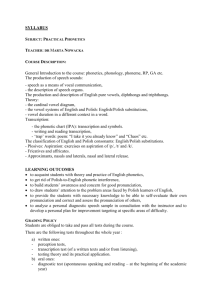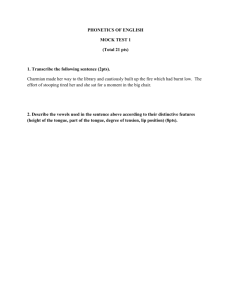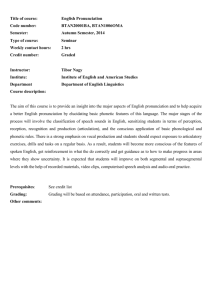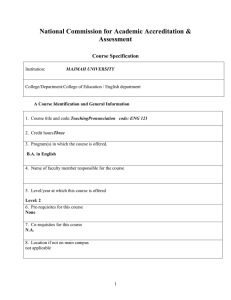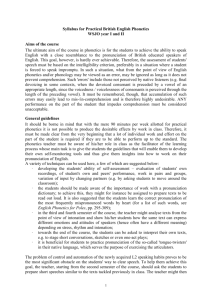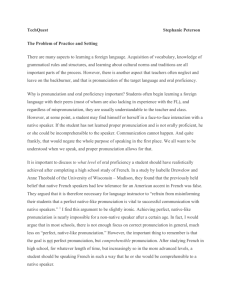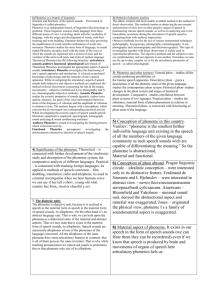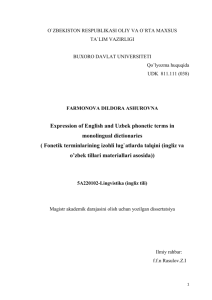Stephanie Peterson - Project Implementation Podcast Blog Entry
advertisement
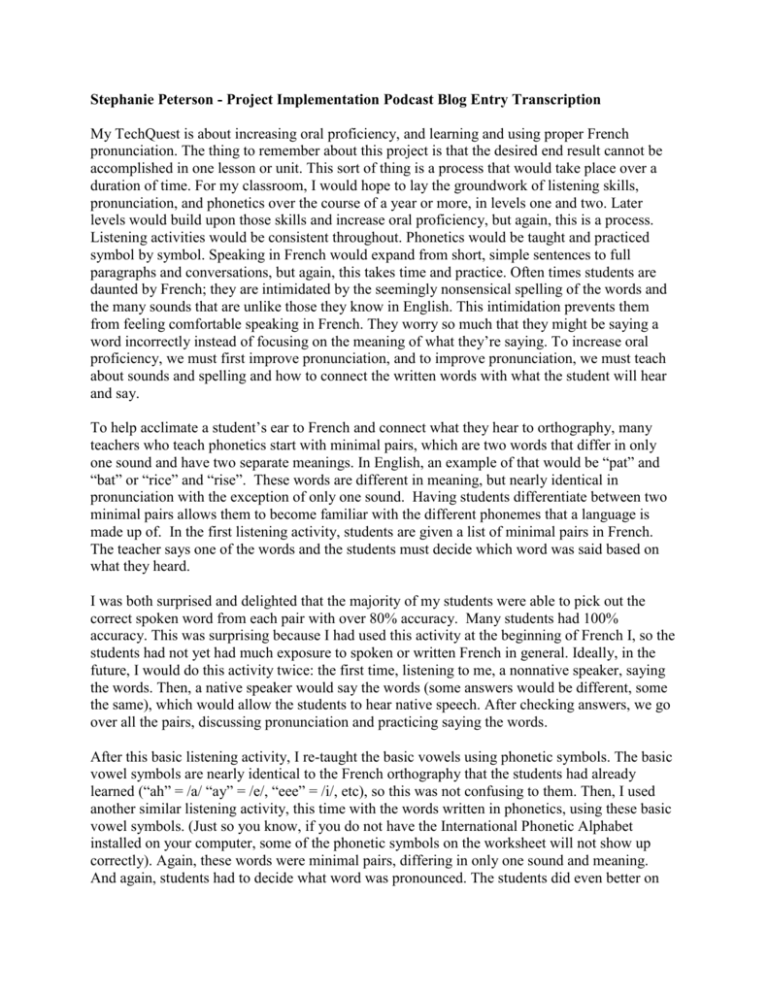
Stephanie Peterson - Project Implementation Podcast Blog Entry Transcription My TechQuest is about increasing oral proficiency, and learning and using proper French pronunciation. The thing to remember about this project is that the desired end result cannot be accomplished in one lesson or unit. This sort of thing is a process that would take place over a duration of time. For my classroom, I would hope to lay the groundwork of listening skills, pronunciation, and phonetics over the course of a year or more, in levels one and two. Later levels would build upon those skills and increase oral proficiency, but again, this is a process. Listening activities would be consistent throughout. Phonetics would be taught and practiced symbol by symbol. Speaking in French would expand from short, simple sentences to full paragraphs and conversations, but again, this takes time and practice. Often times students are daunted by French; they are intimidated by the seemingly nonsensical spelling of the words and the many sounds that are unlike those they know in English. This intimidation prevents them from feeling comfortable speaking in French. They worry so much that they might be saying a word incorrectly instead of focusing on the meaning of what they’re saying. To increase oral proficiency, we must first improve pronunciation, and to improve pronunciation, we must teach about sounds and spelling and how to connect the written words with what the student will hear and say. To help acclimate a student’s ear to French and connect what they hear to orthography, many teachers who teach phonetics start with minimal pairs, which are two words that differ in only one sound and have two separate meanings. In English, an example of that would be “pat” and “bat” or “rice” and “rise”. These words are different in meaning, but nearly identical in pronunciation with the exception of only one sound. Having students differentiate between two minimal pairs allows them to become familiar with the different phonemes that a language is made up of. In the first listening activity, students are given a list of minimal pairs in French. The teacher says one of the words and the students must decide which word was said based on what they heard. I was both surprised and delighted that the majority of my students were able to pick out the correct spoken word from each pair with over 80% accuracy. Many students had 100% accuracy. This was surprising because I had used this activity at the beginning of French I, so the students had not yet had much exposure to spoken or written French in general. Ideally, in the future, I would do this activity twice: the first time, listening to me, a nonnative speaker, saying the words. Then, a native speaker would say the words (some answers would be different, some the same), which would allow the students to hear native speech. After checking answers, we go over all the pairs, discussing pronunciation and practicing saying the words. After this basic listening activity, I re-taught the basic vowels using phonetic symbols. The basic vowel symbols are nearly identical to the French orthography that the students had already learned (“ah” = /a/ “ay” = /e/, “eee” = /i/, etc), so this was not confusing to them. Then, I used another similar listening activity, this time with the words written in phonetics, using these basic vowel symbols. (Just so you know, if you do not have the International Phonetic Alphabet installed on your computer, some of the phonetic symbols on the worksheet will not show up correctly). Again, these words were minimal pairs, differing in only one sound and meaning. And again, students had to decide what word was pronounced. The students did even better on this activity than on the previous one. I believe the reason for this is that writing a word in phonetics simplifies the “spelling”. Many words in French contain numerous vowels which may only be pronounced as one sound. For example “eau” is pronounced “oh” or /o/. A beginning language student would see these three consecutive vowels and most likely be confused about how to say the word correctly. Phonetically “eau” is written as one symbol, /o/, which is far simpler to understand, pronunciation-wise. Again, a change I would like for this exercise would be the addition of speech from a native speaker. The important lesson students learn from minimal pairs is how important pronunciation is. Mixing up a single sound can change the entire meaning of a word. For example, a preferred example is the two phrases “J’ai pu” and “J’ai poux.” These two phrases differ in only one vowel sound, but have two very different meanings. “J’ai pu” means, “I was able”, whereas “J’ai poux” means, “I have lice.” Imagine the confusion that could arise if the wrong vowel was used! Obviously this is just the first of many exercises and activities used to familiarize students with spoken French. The students would go on to learn additional phonemes, and how to string them together from monosyllabic words to full paragraphs. In addition, they would learn how those phonemes relate to orthography and vice versa. Although there are, of course, exceptions to every rule, the important thing is that students understand how the spelling connects to the sounds they hear and say. Once they have this down, their pronunciation is greatly improved, as is their oral proficiency.
